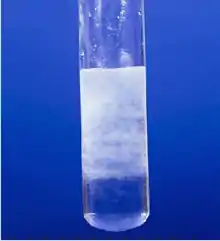Beryllium hydroxide
Beryllium hydroxide, Be(OH)2, is an amphoteric hydroxide, dissolving in both acids and alkalis. Industrially, it is produced as a by-product in the extraction of beryllium metal from the ores beryl and bertrandite.[4] The natural pure beryllium hydroxide is rare (in form of the mineral behoite, orthorhombic) or very rare (clinobehoite, monoclinic).[5][6] When alkali is added to beryllium salt solutions the α-form (a gel) is formed. If this left to stand or boiled, the rhombic β-form precipitates.[7] This has the same structure as zinc hydroxide, Zn(OH)2, with tetrahedral beryllium centers.[8]
 | |
| Names | |
|---|---|
| IUPAC name
Beryllium hydroxide | |
| Other names
Hydrated beryllia | |
| Identifiers | |
3D model (JSmol) |
|
| ChEBI | |
| ChemSpider | |
| ECHA InfoCard | 100.033.048 |
| EC Number |
|
| 1024 | |
| MeSH | Beryllium+hydroxide |
PubChem CID |
|
| RTECS number |
|
| UNII | |
CompTox Dashboard (EPA) |
|
| |
| |
| Properties | |
| BeH2O2 | |
| Molar mass | 43.026 g·mol−1 |
| Appearance | Vivid white, opaque crystals |
| Density | 1.92 g cm−3[1] |
| Melting point | (decomposes) |
| 0.0000023965 g/L | |
| Structure | |
| Linear | |
| Thermochemistry | |
Heat capacity (C) |
1.443 J K−1 |
Std molar entropy (S |
47 J·mol−1·K−1[2] |
Std enthalpy of formation (ΔfH⦵298) |
-904 kJ mol−1[2] |
Gibbs free energy (ΔfG˚) |
-818 kJ/mol |
| Hazards | |
| Main hazards | Carcinogenic |
| GHS pictograms |    |
| GHS Signal word | Danger |
| NFPA 704 (fire diamond) | |
| Lethal dose or concentration (LD, LC): | |
LD50 (median dose) |
4 mg kg−1 (intravenous, rat) |
| NIOSH (US health exposure limits): | |
PEL (Permissible) |
TWA 0.002 mg/m3 C 0.005 mg/m3 (30 minutes), with a maximum peak of 0.025 mg/m3 (as Be)[3] |
REL (Recommended) |
Ca C 0.0005 mg/m3 (as Be)[3] |
IDLH (Immediate danger) |
Ca [4 mg/m3 (as Be)][3] |
| Related compounds | |
Related compounds |
Aluminium oxide |
Except where otherwise noted, data are given for materials in their standard state (at 25 °C [77 °F], 100 kPa). | |
| Infobox references | |
Reactions
Beryllium hydroxide is difficult to dissolve in water. With alkalis it dissolves to form the tetrahydroxoberyllate/tetrahydroxidoberyllate anion, [Be(OH)4]2−.[9] With sodium hydroxide solution:
- 2NaOH(aq) + Be(OH)2(s) → Na2Be(OH)4(aq)
With acids, beryllium salts are formed.[9] For example, with sulfuric acid, H2SO4, beryllium sulfate is formed:
- Be(OH)2 + H2SO4 → BeSO4 + 2H2O
Beryllium hydroxide dehydrates at 400 °C to form the soluble white powder, beryllium oxide:[9]
- Be(OH)2 → BeO + H2O
Further heating at higher temperature produces acid insoluble BeO.[9]
References
- Pradyot Patnaik. Handbook of Inorganic Chemicals. McGraw-Hill, 2002, ISBN 0-07-049439-8
- Zumdahl, Steven S. (2009). Chemical Principles 6th Ed. Houghton Mifflin Company. ISBN 978-0-618-94690-7.
- NIOSH Pocket Guide to Chemical Hazards. "#0054". National Institute for Occupational Safety and Health (NIOSH).
- Jessica Elzea Kogel, Nikhil C. Trivedi, James M. Barker and Stanley T. Krukowski, 2006, Industrial Minerals & Rocks: Commodities, Markets, and Uses, 7th edition, SME, ISBN 0-87335-233-5
- Mindat, http://www.mindat.org/min-603.html
- Mindat, http://www.mindat.org/min-1066.html
- Mary Eagleson, 1994, Concise encyclopedia chemistry, Walter de Gruyter, ISBN 3-11-011451-8
- Greenwood, Norman N.; Earnshaw, Alan (1997). Chemistry of the Elements (2nd ed.). Butterworth-Heinemann. ISBN 978-0-08-037941-8.
- Egon Wiberg, Arnold Frederick Holleman (2001) Inorganic Chemistry, Elsevier ISBN 0-12-352651-5
